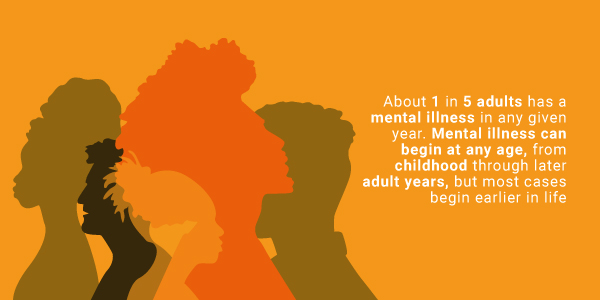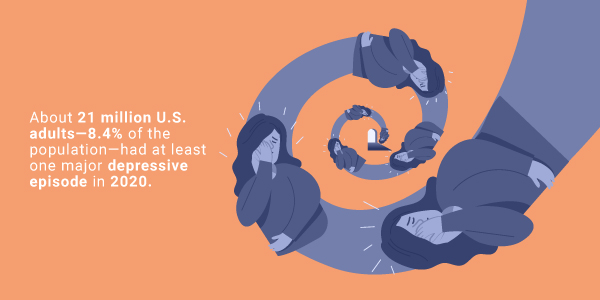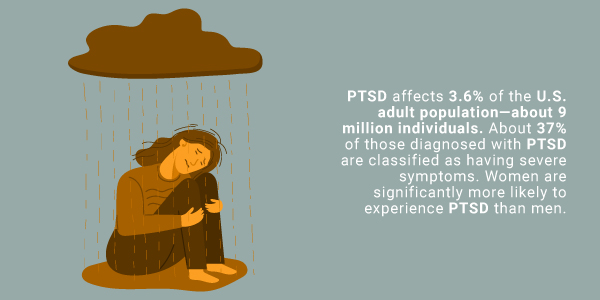What Are The Types Of Mental Health Disorders?
Mental health disorders are conditions that affect people’s mood, thinking, and behavior. Learn more about them here.
Written and medically reviewed by the clinical team at Ripple Ranch Recovery Center, including licensed therapists, addiction specialists, and medical professionals.
What Is Mental Health?
Mental health has gained more recognition in recent years. People are sharing their personal struggles more openly, and treatment options are becoming more easily accessible through the advance of the internet and the widespread availability of resources. Mental health refers to our emotional, psychological, and social well-being.
Mental illness, also referred to as mental health disorders, covers an enormous range of conditions and symptoms that affect mood, thinking, and behavior. These can range from fairly mild, only impacting life in subtle, more manageable ways, to very serious, derailing daily life.

Table of Contents
Learn More About Ripple Ranch Recovery Center
Our team is standing by to discuss your situation and options. Your call is fully confidential, and no obligation is required
Mental Health Overview
Conditions That Can Impact Mental Health
Commonly seen conditions include depression, anxiety, attention-deficit/hyperactivity disorder (ADHD), eating disorders, posttraumatic stress disorder (PTSD), and substance use disorders. Some symptoms of these conditions may seem to apply to everyone. For example, it is common to experience anxiety occasionally, such as before a big meeting, dealing with stressful personal relationships, or driving through rush hour. Periodic episodes of sadness or feeling down is all very normal as well.
However, mental health concerns become a more significant issue when they start interfering with people’s ability to function. Active mental health disorders can impede progress at school or work, impact social relationships, and prohibit the capacity to engage in or complete daily tasks.
Signs and Symptoms of Mental Illness
The signs and symptoms depend on the type of mental illness and the severity. However, there are some commonalities shared between the different mental health disorders. Some signs to watch out for include:
- Extreme mood changes
-
Illogical thinking
-
Nervousness or high anxiety
-
Apathy or loss of drive
-
Decline in functioning at school, work, etc.
-
Major or erratic shifts in mood
-
Withdrawal from interests, relationships, or social responsibilities
-
Heightened sensitivity
-
Changes in sleep patterns or appetites
-
Problems thinking clearly or cogently
-
Substance abuse
These can all be signs of developing or worsening mental health concerns and should not be taken lightly.
Why Is Mental Health Important?
Mental health is an essential aspect of daily life. Good mental health means life satisfaction, contentment, and the ability to bounce back from challenging circumstances and make deep connections with others.
On the other hand, poor mental health can lead to many struggles. People may find it challenging to cope with complex situations at work or school or withdraw from close relationships. It affects every area of life and can hold people back from full enjoyment and participation.

What Are the Types of Mental Health Disorders?
Mental health disorders can present in many different ways. These conditions profoundly impact day-to-day living and may also affect the ability to relate to others. The symptoms of each disorder vary, sometimes overlapping or co-occurring with another disorder. Depression, anxiety, ADHD, eating disorders, and substance use disorders are some of the more commonly recognized conditions.
Depression
Depression affects around 8.4% of the U.S. adult population. It is more serious than simply feeling blue or dealing with feelings of sadness or apathy. A depressive episode can last a few months or even years if left untreated. Symptoms can vary, but they often include changes in sleep, appetite, energy, and engagement in life.1
It can lead to thoughts of hopelessness, physical aches and pains, and suicidal thoughts. Depression does not have a single cause and can occur at any age. Fortunately, healing is possible with early detection, diagnosis, and a treatment plan consisting of medication, psychotherapy, and healthy lifestyle choices.
Anxiety
Anxiety disorders are currently the most common mental health disorder in the U.S., with 19.1% of adults diagnosed. While everyone has moments of fear or discomfort when confronting difficult situations, overwhelming feelings of intense fear and internal distress that prevent people from participating in everyday activities are often the biggest indicators of an anxiety disorder.2
Symptoms can be emotional, such as feelings of dread, apprehension, or anticipating the worst, or physical, such as a racing heart, upset stomach, or shortness of breath.
Understanding Anxiety
Attention-Deficit/Hyperactivity Disorder (ADHD)
Attention-deficit/hyperactivity disorder (ADHD) is a mental health condition characterized by either inattention, hyperactivity, and/or impulsivity. Teachers will often discover this condition in elementary school, as traditional classroom instruction can highlight some of the challenges ADHD brings, but some cases go undiagnosed until adulthood.
Insomnia
Insomnia is sometimes brushed over as a ‘normal’ issue but can be indicative of a larger problem. Everyone has a few nights where they struggle to get adequate sleep, but people with insomnia are consistently unable to get enough sleep at night to function in the daytime.
The condition can affect falling asleep, difficulty staying asleep, or both. It is rarely an isolated symptom and can often help people and their doctors discover what else may be affecting them.
Addiction and Substance Use Disorders
Addiction, also known as substance use disorder, is a chronic mental illness characterized by the uncontrollable urge to misuse alcohol or drugs despite the negative consequences. Typical indicators include developing tolerance and becoming dependent on the substance.
Substance use disorders often occur simultaneously with mental illness, usually due to relying on drugs or alcohol to cope with overwhelming symptoms. Trying to self-medicate and manage symptoms of a mental illness can quickly escalate to a disorder of its own. The combination of mental health and substance use disorders is called dual diagnosis or co-occurring disorders.
The best treatment for dual diagnosis is integrated intervention—when a person receives care for both their diagnosed mental illness and substance use disorder.
Bipolar Disorder
Bipolar disorder is characterized by dramatic shifts in mood, energy, and ability to think clearly. There is usually a swing of emotional opposites referred to as mania (elevated, high moods) and depression (low moods) far beyond the normal range.
It affects all genders equally and usually sets in early adulthood around the age of twenty-five. Approximately 82.9% of people with this condition have a severe impairment, the highest among mood disorders. Treatment often includes medication, psychotherapy, and focusing on a healthy lifestyle to manage symptoms.3
Schizophrenia
Schizophrenia is a complex mental illness characterized by a disconnection from reality. Common symptoms include hallucinations, delusions, disordered thinking, diminished abilities, isolation, and cognitive issues. While this is a lifelong and severe disorder, a strong treatment plan can help manage symptoms and improve daily life.
Posttraumatic Stress Disorder (PTSD)
Posttraumatic stress disorder (PTSD) occurs when people experience or witness a traumatic event. An estimated 60% of men and 50% of women experience trauma at least once in their lives, with around 12 million U.S. adults having PTSD each year.4
A traumatic event can be any distressing situation, such as an accident, physical or sexual assault, military service, or natural disaster. Symptoms can include flashbacks, avoidance, negative self-talk, hypervigilance, and, in children, disruption in developmental milestones.
PTSD is another type of disorder that often occurs as a dual diagnosis, commonly co-occurring with depression, anxiety, or substance use disorder.
Eating Disorders
Eating disorders refer to extreme food and weight issues that can cause life-threatening physical and emotional symptoms. The four most common eating disorders include:
- Anorexia Nervosa: Anorexia nervosa is characterized by self-starving and usually obsessing over losing weight despite being severely underweight. Symptoms like body dysmorphia and fear of gaining weight generally drive this disorder.
-
Bulimia Nervosa: Bulimia nervosa is focused more on a binge/purge cycle, meaning people would uncontrollably consume large amounts of food and force themselves to vomit, use laxatives, fast, and/or exercise excessively to make up for their eating behavior.
-
Binge-Eating Disorder: Binge-eating disorder involves overeating unusually large amounts of food. Unlike bulimia nervosa, this eating disorder does not involve behaviors that try to compensate for overeating.
-
Avoidant Restrictive Food Intake Disorder (ARFID): Avoidant restrictive food intake disorder (ARFID) refers to limiting the type or amount of food consumed, commonly resulting in a lack of nutrition and weight loss.
Borderline Personality Disorder (BPD)
Borderline personality disorder, or BPD, causes difficulty regulating emotion. Similar to bipolar disorder, there can be significant mood fluctuations, from high to low emotions. Patients struggling with BPD often feel emotions more intensely than others and find it difficult to move past negative emotions.
The primary cause is not fully understood yet, but most research points to some combination of genetics, environment, and brain function.

Characteristics of Good Mental Health
Mental health is a multifaceted issue. Many people are concerned with the effects of poor mental health, but it is also helpful to identify the characteristics of good mental health and mental stability. Four symptoms of mental stability are life satisfaction, resilience, social support, and emotional flexibility.
Flexibility
The ability to enjoy life is frequently used as an indicator of good mental health and wellness. Flexibility is the degree to which people enjoy the most important aspects of their life without letting obstacles and roadblocks severely interfere with their overall outlook on life.
Resilience
Resilience is the ability to bounce back from adversity. People who are resilient tend to have a positive view of their capability to cope with challenges and seek out social support when needed.
Social Support
Social support is essential for positive mental health. Loneliness is linked to physical and mental health issues, including cardiovascular disease, depression, memory problems, drug misuse, alcohol misuse, and altered brain function. Therefore, having and maintaining quality relationships, not necessarily a lot of relationships, can go a long way.
Emotional Flexibility
Having rigid expectations can sometimes create added stress. Emotional flexibility may be just as important as cognitive flexibility. Mentally healthy people experience a range of emotions and allow themselves to express these feelings.
Challenges to Mental Health
There are many challenges to mental health, some of which are under the individual’s control, but many are attributed to outside influence.
Discrimination
Discrimination is being unfairly treated due to personal characteristics, such as age, race, ethnicity, disability, sexual orientation, or gender identity. People are more likely to develop anxiety and depression when they are subjected to repeated discrimination.
Exposure to Trauma
Exposure to trauma is another prevalent challenge. When people are involved in traumatic experiences, they are at a higher risk for anxiety, depression, changes in mood, feelings of hopelessness, and PTSD.
Genetics
Genetics has also been shown to play a prominent role in mental health disorders. Mental illnesses such as ADHD, bipolar disorder, and schizophrenia all have a strong biological component. For example, people with a family history of mental health disorders are more likely to develop one themselves. Additionally, studies indicate that specific genes can increase people’s susceptibility to various disorders, such as substance use disorder.
Low Income
Low Income
People with low income have been linked to increased stress, anxiety, and depression and experience less access to mental health services when necessary.
Medical Illness
Medical conditions, particularly chronic illnesses that affect daily life, can cause psychological distress.
Poor Access to Health Services
Those with limited access to health services often suffer from diminished mental and physical health, as they are unable to receive proper help and treatment.
Causes and Risk Factors of Mental Illness
Several factors influence the development of mental illness, with some more influential than others.
What Causes Mental Illness?
What are the causes of mental illness? Although the exact cause of most mental illnesses is unknown, it is becoming clear through research that many conditions are caused by biological, environmental, and psychological factors. These are as follows:
- Biological Influence: Many mental illnesses are correlated to abnormal functioning of nerve cell circuits or pathways that connect particular brain regions. This can be due to genetics, injury, or some abnormality of genes specific to the individual. Mental illness is influenced or triggered by the interaction of multiple genes and other factors (e.g., stress, abuse, or a traumatic event).
-
Environmental Influence: Environmental factors that can significantly impact mental health include poverty, crime, a dysfunctional family, and discrimination. Even an unhealthy work environment can significantly impact mental health.
-
Psychological Influence: Psychological factors like trauma, inability to relate to others, and relationships in people’s daily life can profoundly influence mental health. For example, managing the emotional effects of a traumatic experience, isolation, or social conflicts can be very stressful.
Risk Factors for Mental Health Disorders
Certain factors may increase the risk of developing a mental health disorder. While risk factors are not concrete indicators of mental illness, they provide awareness. Relevant risk factors include:
- Continuous Social and Economic Pressure: Continuous social and economic pressure is a huge issue when discussing preventable risks. For example, peer pressure is a known factor in substance use disorders. Socioeconomic stress can also cause increased levels of stress, depression, anxiety, and push susceptible individuals into deeper mental health struggles.
-
Biological Factors: Biological factors are something that we have no control over. A family history of mental illness in a blood relative, such as a parent or sibling, or a previous mental illness increases the chances of developing a mental health disorder.

How to Stay Mentally Healthy
There are some simple ways to prioritize mental health. Many of these can be done with or without help from mental health professionals.
Physical Wellness
Physical exercise is a tool that can reduce feelings of stress and depression and improve mood.
Prioritize Sleep
Over the long term, a lack of quality sleep can increase feelings of depression. Thus, having a regular sleep schedule and getting enough quality sleep every night is important.
Get Involved
Helping others can be a good way to steer the focus away from personal struggles. One way people can accomplish this is by getting involved in the community or neighborhood and volunteering their time.
Develop Healthy Coping Mechanisms
Developing healthy coping skills—methods used to deal with stressful situations—is an essential step to maintaining good health. They can help people face problems, take action, be flexible, and persevere through difficult times.
Utilize Your Support Network
Stay connected with friends and family. Having healthy relationships with others creates a strong support system.
Maintain a Positive Outlook
It is important to stay positive when dealing with mental health issues. This does not mean people shouldn’t feel negative emotions, as everyone has to deal with difficult situations. Staying mentally healthy allows people to acknowledge negative feelings, pursue the deeper reason or trigger, and move forward.
Additional Tips to Achieving and Maintaining Mental Wellness
How Common Are Mental Health Disorders?
Mental health disorders are a widespread issue in the U.S. and around the world. Chances are high that you or someone close to you has dealt with a mental health disorder just this year.
Prevalence
Recent statistics show that one in five adults in the U.S. will deal with mental illness in any given year. In addition, over 50% of the population will have a mental health disorder at some point in their lives.5
Depressive illnesses affect around 10% of American adults each year, and a whopping 18% of people suffer from anxiety disorders.6
Age of Onset
Mental health disorders can become an issue at any age, but some are more likely to occur in childhood versus adulthood. For instance, ADHD, anxiety, eating disorders, and PTSD appear more often in children than adults.
Additionally, major depression can occur at any age, but the average age of onset is around mid-twenties. Bipolar disorder, schizophrenia, and borderline personality disorder tend to occur in early adulthood.

How Are Mental Health Disorders Treated?
Mental health disorders are treated in a number of ways. Medication, psychotherapy, alternative therapies, brain stimulation therapies, and self-care are all valid forms of treatment and can be used in combination with one another.
Medication
In many cases, pharmaceutical treatment is an effective option for mental illness. Antidepressants, antipsychotics, and other prescriptions can rebalance chemical abnormalities in the brain that are causing symptoms.
Psychotherapy
Psychotherapy, or talk therapy, is another popular treatment for mental health disorders. Regular counseling and talking with a therapist can uncover the deeper elements that may be affecting people’s mental health. Therapists will help identify potential issues and equip patients with coping strategies and tools to work through problems.
Alternative Therapies
Complementary and alternative therapies for mental health problems include yoga, electrical stimulation, and dietary supplements, such as omega-3 fatty acids and kava. These approaches may increase feelings of well-being, reduce anxiety, ease symptoms of depression, and aid relaxation.
Brain Stimulation Therapies
Brain stimulation therapy is a category of procedures in which electrodes or magnets, usually placed on the scalp or inserted into the brain, are used to treat some neurological disorders or serious psychiatric disorders that do not respond successfully to commonly used therapies and medications.
Self-Help
Self-help means taking the time to participate in activities and engage in things that promote well-being and improve both physical and mental health. When it comes to mental health, self-care can help people manage stress, lower their risk of illness, and increase energy.
Get Help With Mental Health Disorders at Ripple Ranch
Here at Ripple Ranch, we can help you find an effective treatment for your mental health concerns. We run a clinically driven program that utilizes evidence-based modalities to treat our patients. We are here to help improve your mental health and guide you towards a better quality of life.
Resources
- 1 https://www.nami.org/About-Mental-Illness/Mental-Health-Conditions/Depression
- 2https://www.nami.org/About-Mental-Illness/Mental-Health-Conditions/Anxiety-Disorders
- 3https://www.nimh.nih.gov/health/statistics/bipolar-disorder
- 4https://www.ptsd.va.gov/understand/common/common_adults.asp
- 5https://www.cdc.gov/mental-health/about/
- 6https://www.hopkinsmedicine.org/health/wellness-and-prevention/mental-health-disorder-statistics





